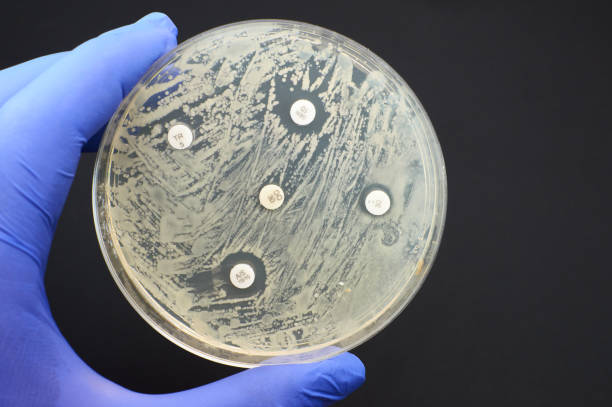Antimicrobial resistance: when drugs becomes ineffective
The most annoying part of it is the rate at which it persistently happens. This occurrences has drawn my attention towards finding out what might possibly be the problem and why the daily increase.
What I am saying in essence is drug resistance among men and women in our society today.
Most people who don't work in the laboratory or who are not a medical personnel may not really understand the danger associated with drug resistance.
 pixabay
pixabayLooking at the above, is a culture plate where bacteria are being cultured for 24 hours. In that plate it seems most of the drugs placed on it were resistant. This occurrences are exactly what we see everyday during our normal routine work in the laboratory.
Well, for those of us who may not really understand what antimicrobial resistance are, I think we should start with a definition.
Antimicrobial Resistance
Antimicrobial Resistance (AMR) occurs when bacteria, viruses, fungi and parasites change over time and no longer respond to medicines making infections harder to treat and increasing the risk of disease spread, severe illness and death
Looking at what the definition is saying, you will be able to understand that even the drugs we call the most active drugs are turning out to be irrelevant and inactive due to its resistance.
In this part of Africa where I come from, antimicrobial resistance has turn out to become a very devastating condition that needs immediate attention. Take for instance some malaria drugs like chloroquine which happens to be the best malaria drug has turn out to be resistance in so many individuals. This is also applicable in some other aspect of ailment.
Taking a look at this report
the rate of resistance to ciprofloxacin, an antibiotic commonly used to treat urinary tract infections, varied from 8.4% to 92.9% for Escherichia coliand from 4.1% to 79.4% for Klebsiella pneumoniae in countries reporting to the Global Antimicrobial Resistance and Use Surveillance System (GLASS).
Klebsiella pneumoniae are common intestinal bacteria that can cause life-threatening infections. Resistance in K. pneumoniae to last resort treatment (carbapenem antibiotics) has spread to all regions of the world. K. pneumoniae is a major cause of hospital-acquired infections such as pneumonia, bloodstream infections, and infections in newborns and intensive-care unit patients. In some countries, carbapenem antibiotics do not work in more than half of the patients treated for K. pneumoniae infections due to resistance.
I think we can easily understand what the report above is really talking about. It simply means that Those drugs we use in treating some diseases which many of us have seen its efficacy and how effective the drugs is, is no longer working in some various individuals.
Imagine colistin which is a last resort drug for the treatment of life threatening infection has been discovered to have some bacterias which are resistant to it. Presently, there is no current effective antibiotics treatment at the moment.
This is also applicable to other drugs. Take for instance rifampicin a drug use in the treatment of tuberculosis.
As it stands now, people are gradually battling with severe infection which there is no available drugs that can be able to cure or bring down the infection due to the so called Antimicrobial Resistance.
My question now is, what is really the cause of Antimicrobial Resistance and how can we work together towards reducing the rate at which we have drug resistance.
causes of antibacterial resistance
antibiotics intake
Most people in our society don't really know how drugs are being taken. The worst part of it is that even some of our health practitioner are still making the same mistake.
How can a person who is having a typhoid fever who is meant to start with a low spectrum drugs be given a higher drugs. Take for example, administering augmentin which is a drug of higher spectrum instead of starting from the lower ones.
These are reasons why most people today are battling with antimicrobial resistance.
Also, the use of antibiotics carelessly can as well result to AMR. Imagine taking antibiotics every single day of your life due to one reason or the other.
poor hygiene
If for instance we keep our environment clean and prevent anything that might probably cause ailment due to bacteria and otherwise. There is no way which we can fall sick or take antibiotics.
It is better to prevent an infection from occuring than to treat them. Preventing ourselves from bacteria infection can as well help us in not to be taking antibiotics all the time.
conclusions
Antimicrobial Resistance is gradually becoming something else.
People suffers from one disease to the other without having a particular drug that can cure their ailment.
It is high time we come together to prevent some of the things we do and try to prevent anything that might probably lead us to antimicrobial resistance.
Thanks for your contribution to the STEMsocial community. Feel free to join us on discord to get to know the rest of us!
Please consider delegating to the @stemsocial account (85% of the curation rewards are returned).
You may also include @stemsocial as a beneficiary of the rewards of this post to get a stronger support.
Congratulations @hillaryisidore! You received a personal badge!
You can view your badges on your board and compare yourself to others in the Ranking
Support the HiveBuzz project. Vote for our proposal!